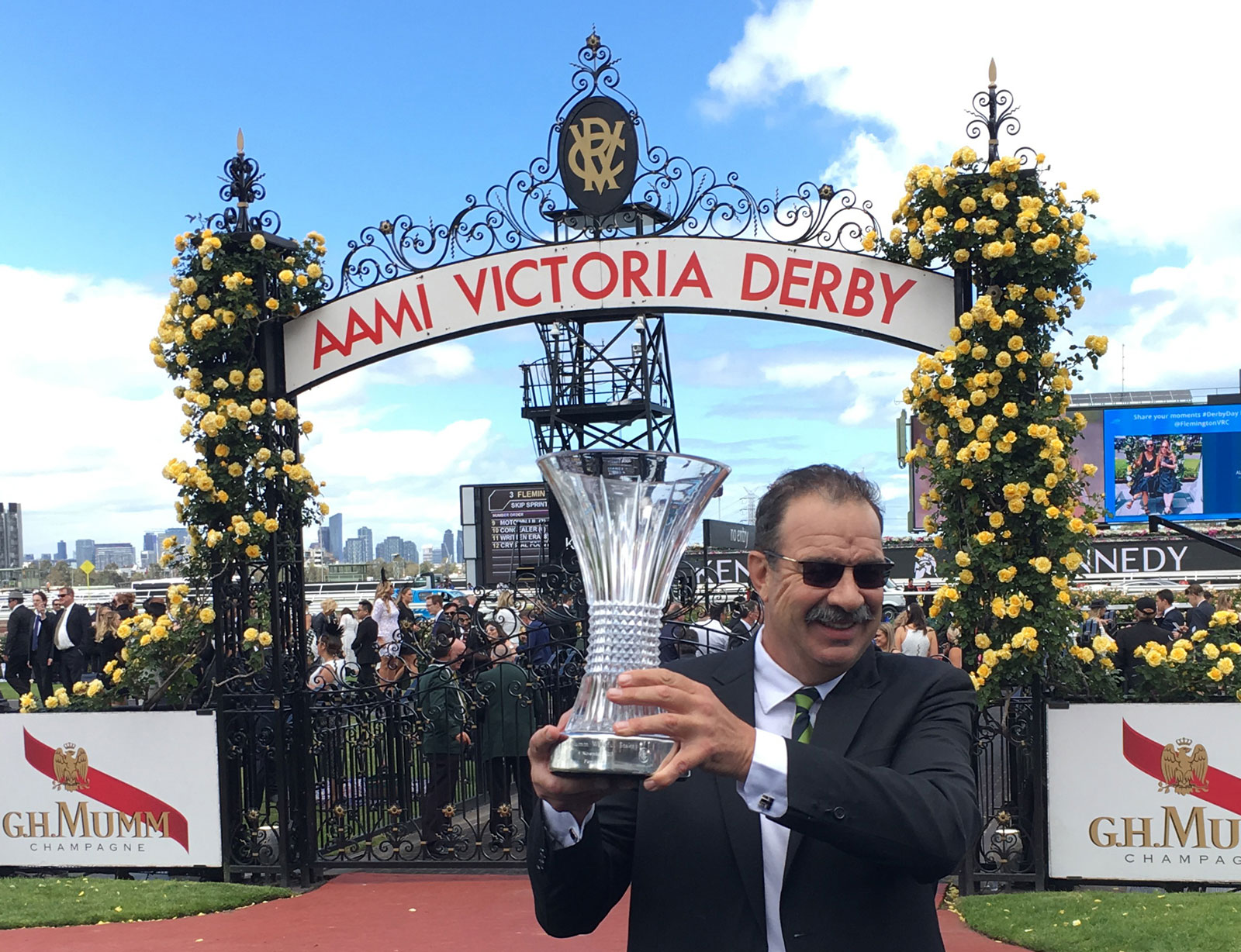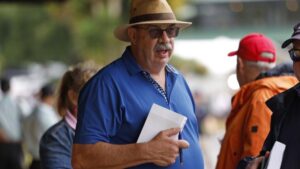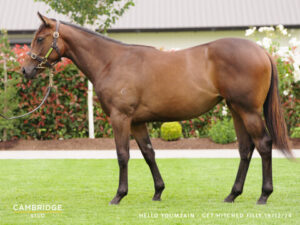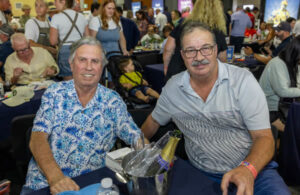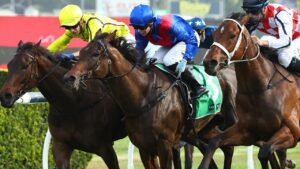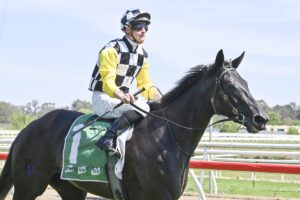Words by Jessica Owers, TDN AUS NZ
John Sargent is a tick over a week away from the G1 Golden Slipper with Four Moves Ahead, and his phone is running hot.
“It reminds me a bit of when I had champion horses in New Zealand,” he said. “I had the fillies Banchee and Il Quello Veloce, and there was Red Ruler who was second in the Derby over here. When you get the good ones, the phone never stops. But that’s part and parcel of the game, and it’s better than getting no calls at all.”
Chestnut filly Four Moves Ahead will be Sargent’s first Slipper horse. She’s had a perfect scamper into the race, undefeated in two starts and a last-time winner of the G2 Sweet Embrace S. She is an exciting racehorse, a red-haired cocktail of physical excellence and pedigree, but Sargent is keeping his head.
“It’s a big deal to have her in this race because it gets you out in the headlines,” he said, “but I just go through the systems. I’ve been training for 40 years now, so you just take every day as it comes. You hope that everything aligns – the draw, track conditions and luck in running – because you can only do so much.”
A way with the ladies
Sargent has long been considered a deft hand with fillies.
Emeralds (Sebring), Four Moves Ahead’s sister, is currently in the stable. He’s had Gust Of Wind (NZ) (Darci Brahma {NZ}), Quintessential (NZ) (Fast ‘N’ Famous), Kirramosa (NZ) (Alamosa {NZ}) and Luvaluva (NZ) (Mastercraftsman {Ire}). Between them, these horses won 13 stakes races, four of which were Oaks races in different jurisdictions.
“I spent five years in England where there’s not a lot of 2-year-old racing,” Sargent said. “They’re a bit easier on the horses, and spend more time with them, the fillies and mares too, and I learned from that.
“But also, I don’t have a big hand in buying the expensive yearlings at the sales. So, very often, when I go to the sales, the horses I like are the fillies because they’re cheaper.”
“I don’t have a big hand in buying the expensive yearlings at the sales. So, very often, when I go to the sales, the horses I like are the fillies because they’re cheaper.” – John Sargent
With Hong Kong out of the fillies’ market, and the local buying bench pointed at future stallions, Sargent has filled his yard for years with the fairer sex.
The most he has paid for a yearling is $250,000, and that was for Sepoy filly Vaishali, who was a daughter of G1 AJC Oaks winner Republic Lass (Canny Lad) and, as such, a half-sister to South African Group 1 winner The Conglomerate (Lonhro).
At New Zealand Bloodstock’s Karaka Yearling Sale this year, Sargent teamed up with Duncan Ramage to the tune of NZ$200,000 for a So You Think (NZ) filly from Cambridge Stud mare Dazzling Lady (NZ) (Lonhro).
But these are an exception. In 50 sale purchases since 2001, the Randwick trainer averaged $43,000 per yearling.
Memories in Malaysia
At 63, John Sargent is 40 years in the game. He has trained in three different racing nations, Australia, New Zealand and Malaysia, and said Hong Kong might have been interesting.
“Hong Kong gets the best riders in the world and the best bloodstock,” he said. “I put my resume in there a few years back and didn’t get it, obviously. Now I’m too old because you’ve got to be under a certain age, but Hong Kong was always a place I thought I’d like to go. Racing is very vibrant there.”
Sargent and wife Susie, with young kids in tow, spent the years 1998 to 2002 in Malaysia, living in Kuala Lumpur. By his third season, Sargent won the Trainer’s Premiership.
“It was tough there to start with,” he said. “Training revolved around big betting because there were no casinos then. All they gambled on were horses, so there was a lot of pressure to produce results. It wasn’t good enough to say this horse might win this or might win that. If they didn’t win, you’d often lose the horses.”
“Training revolved around big betting because there (Malaysia) were no casinos then. All they gambled on were horses, so there was a lot of pressure to produce results.” – John Sargent
Sargent’s time in Malaysia lifted his game. He trained on a two-week circuit that involved floating horses between Perak Turf Club in Ipoh, Penang Turf Club, Selangor Turf Club in Kuala Lumpur and Singapore.
“It was an interesting time for me,” he said. “There were some good trainers and good jockeys there, and it was a good starting point for me. It set me up to go back to New Zealand with some money to build my own stables.”
The trainer said he’s never taken more showers than he did during his time in Malaysia. The climate was oppressive every day of the year, along with a violent home invasion that found he, Susie and the kids threatened at knife point.
“They were called the Squirrel Gang, about eight of them,” Sargent said. “They came through the golf course where we were living in Kuala Lumpur, and woke us up with a knife to our throats and golf clubs over our heads. They said they’d kill us if we didn’t give them all the money we had. They tied us up, two babies in the bedroom, and got away.”
Sargent said the incident had nothing to do with racing, as far as he knew. Malaysian gangs have long been a problem in the cities, with squirrel gangs so-called for their leaping onto passing vehicles and stealing freight. The gang was shot and killed within a fortnight.
The deep voice of reason
In the years after Malaysia, Sargent was back in New Zealand with 150 horses in his charge. When he relocated to Randwick in 2013, after a number of years with a satellite facility at Warwick Farm, he brought his string down to today’s 35.
The yard sits on the busy intersection of Anzac Parade and High Street, stables once occupied by trainer Neville Begg. In fact, Sargent’s good gelding Brandenburg (NZ) (Burgundy {NZ}), winner of last season’s G2 Hobartville S., lives in the box once kept by Emancipation (Bletchingly).
Sargent is at the yard every day, a commitment to racing that goes beyond the financial. He plays a bit of golf or hits the gym, but country roots make him most at home among the thoroughbreds. He headed south this week for the Magic Millions Adelaide Yearling Sale, with a good attitude and a well-worn catalogue under his arm.
“I think about breeding a lot when it comes to a horse,” Sargent said. “It’s a bit of a hobby of mine. I like to find a Group 1 winner in the first three dams, but then I also like a horse that walks out of the box, stands up and hits you. When you’ve been looking at horses for 40-odd years, you learn to recognise what sort suits you, be it a good walk or nice eye.”
Sargent said the big prices of 2021 are bad news.
“They’re not good for me, that’s for sure,” he said, a bit of humour disguising the serious end of this year’s record prices.
“You used to be able to buy a nice horse for $80,000, and now you need $150,000 or more. It’s ridiculous. But it’s being pushed because the stakes are so good in Australia, and people can afford to pay because they’re getting the returns. But unless you’ve got a big syndicator behind you, it’s very hard now to buy the good horses.”

